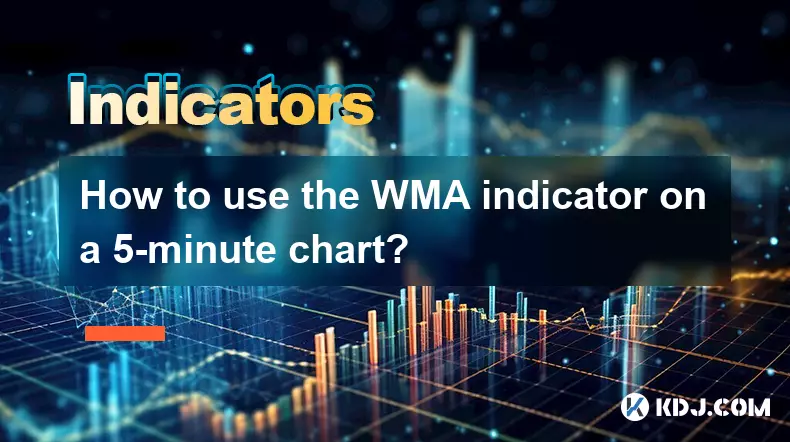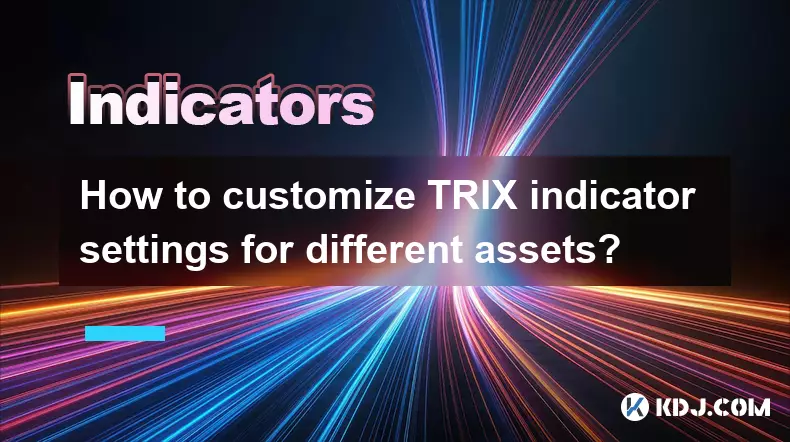-
 bitcoin
bitcoin $100977.009184 USD
-2.05% -
 ethereum
ethereum $3282.009150 USD
-3.23% -
 tether
tether $0.999813 USD
-0.02% -
 xrp
xrp $2.208254 USD
-4.89% -
 bnb
bnb $951.411089 USD
0.55% -
 solana
solana $155.761205 USD
-2.84% -
 usd-coin
usd-coin $1.000217 USD
0.02% -
 tron
tron $0.284475 USD
-1.28% -
 dogecoin
dogecoin $0.162363 USD
-1.53% -
 cardano
cardano $0.533988 USD
-0.47% -
 hyperliquid
hyperliquid $39.174339 USD
-3.22% -
 chainlink
chainlink $14.724828 USD
-1.16% -
 bitcoin-cash
bitcoin-cash $477.297986 USD
-1.28% -
 zcash
zcash $554.227426 USD
17.30% -
 ethena-usde
ethena-usde $0.998995 USD
-0.03%
How to use the WMA indicator on a 5-minute chart?
The WMA boosts crypto trading precision on 5-minute charts by prioritizing recent prices, helping spot momentum shifts and entry points faster than SMA or EMA.
Nov 06, 2025 at 03:19 pm

Understanding the WMA Indicator in Cryptocurrency Trading
The Weighted Moving Average (WMA) is a technical analysis tool widely used in cryptocurrency trading to identify trends and potential reversal points. Unlike the Simple Moving Average (SMA), the WMA assigns greater weight to recent price data, making it more responsive to new information. This sensitivity makes it particularly effective on shorter timeframes such as the 5-minute chart, where rapid price movements are common.
The WMA helps traders detect momentum shifts earlier than other moving averages due to its emphasis on current prices.When applied to a 5-minute chart, the WMA can filter out market noise while still capturing meaningful intraday trends. Traders often use this indicator to confirm entry and exit signals, especially when combined with volume analysis or other oscillators like the RSI or MACD.
Setting Up the WMA on a 5-Minute Chart
- Open your preferred cryptocurrency trading platform that supports custom indicators, such as TradingView, Binance, or MetaTrader.
- Navigate to the chart settings and select the 5-minute timeframe for the asset you're analyzing, such as BTC/USDT or ETH/USD.
- Locate the 'Indicators' menu and search for 'Weighted Moving Average' or type WMA into the search bar.
- Apply the WMA to the chart and adjust the period length—common choices include 9, 14, or 20 periods depending on trading style.
- Customize the visual appearance by changing the line color or thickness to improve readability alongside price action.
Interpreting WMA Signals in Fast Markets
- A rising WMA indicates bullish momentum, suggesting that recent buying pressure is increasing on the 5-minute chart.
- A falling WMA reflects bearish momentum, signaling stronger selling activity over the selected period.
- Price crossovers above the WMA may serve as buy signals, especially when confirmed by rising trading volume.
- Conversely, price crossing below the WMA can indicate a shorting opportunity or a reason to exit long positions.
- Divergences between price and WMA direction—such as price making higher highs while the WMA flattens—can warn of weakening trends.
Combining WMA with Other Tools for Precision
- Pair the WMA with a shorter-term EMA (e.g., 5-period) to create a dual-moving-average crossover strategy tailored for scalping.
- Use support and resistance levels identified through horizontal zones to validate WMA-generated signals.
- Overlay the Relative Strength Index (RSI) to check whether a WMA crossover occurs in overbought or oversold territory.
- Incorporate candlestick patterns such as engulfing bars or dojis near the WMA line to refine entry timing.
- Monitor order book depth on exchanges to assess whether WMA-based signals align with real liquidity conditions.
Frequently Asked Questions
What is the optimal WMA period for 5-minute crypto charts?A 9-period or 14-period WMA is commonly used for 5-minute charts. Shorter periods increase sensitivity, which suits volatile assets like cryptocurrencies, allowing quicker responses to price changes.
Can the WMA be used alone for trading decisions?While the WMA provides valuable insights, relying solely on it increases risk. It performs best when integrated with volume analysis, key price levels, and additional confirmation tools to reduce false signals.
How does WMA differ from EMA in short-term trading?Both prioritize recent prices, but the WMA applies linear weighting, giving the most recent data the highest multiplier. The EMA uses exponential smoothing, which may react slightly slower in abrupt market moves typical of 5-minute crypto charts.
Does the WMA work well during low-volume hours?Its effectiveness diminishes during low-liquidity periods, such as late UTC nights, because thin markets can generate misleading crossovers. Traders should consider filtering signals based on average volume thresholds.
Disclaimer:info@kdj.com
The information provided is not trading advice. kdj.com does not assume any responsibility for any investments made based on the information provided in this article. Cryptocurrencies are highly volatile and it is highly recommended that you invest with caution after thorough research!
If you believe that the content used on this website infringes your copyright, please contact us immediately (info@kdj.com) and we will delete it promptly.
- BlockDAG, Avalanche, Dogecoin: Crypto's Leading Trio in 2025
- 2025-11-07 22:05:01
- Layer 2 Coins: Will There Be a Potential Explosion by 2026?
- 2025-11-07 16:50:02
- Filecoin, ICP, and the AI Infrastructure Renaissance: Is History Repeating?
- 2025-11-07 16:50:02
- Bitcoin's Wild Ride: Surges, Zeros, and the Search for Stability
- 2025-11-07 17:05:01
- XRP, Bitcoin, and the Rally: What's the Deal, New York?
- 2025-11-07 17:25:01
- Filecoin, DePIN, and a Technical Breakout: What's the Buzz?
- 2025-11-07 17:05:01
Related knowledge

How do professional traders use the TRIX indicator?
Nov 06,2025 at 04:40pm
Understanding the TRIX Indicator in Crypto TradingThe TRIX (Triple Exponential Average) indicator is a momentum oscillator used by professional trader...

Can I use the TRIX indicator on my mobile trading app?
Nov 07,2025 at 07:40pm
The TRIX indicator, a momentum oscillator designed to filter out short-term fluctuations and highlight long-term trends, has become increasingly popul...

How to code a simple TRIX indicator script in Pine Script?
Nov 07,2025 at 06:20am
How to Code a Simple TRIX Indicator in Pine Script The TRIX (Triple Exponential Moving Average) indicator is widely used in cryptocurrency trading to ...

How to trade TRIX indicator signals on the 1-hour chart?
Nov 07,2025 at 05:39am
Bitcoin's Role in Decentralized Finance1. Bitcoin remains the cornerstone of decentralized finance, serving as a benchmark for value and security acro...

Can the TRIX indicator be used for long-term investing?
Nov 06,2025 at 02:19pm
Understanding the TRIX Indicator in Cryptocurrency Markets1. The TRIX (Triple Exponential Average) indicator is a momentum oscillator designed to filt...

How to customize TRIX indicator settings for different assets?
Nov 06,2025 at 03:39pm
Understanding the TRIX Indicator in Cryptocurrency Trading1. The TRIX (Triple Exponential Average) indicator is a momentum oscillator designed to filt...

How do professional traders use the TRIX indicator?
Nov 06,2025 at 04:40pm
Understanding the TRIX Indicator in Crypto TradingThe TRIX (Triple Exponential Average) indicator is a momentum oscillator used by professional trader...

Can I use the TRIX indicator on my mobile trading app?
Nov 07,2025 at 07:40pm
The TRIX indicator, a momentum oscillator designed to filter out short-term fluctuations and highlight long-term trends, has become increasingly popul...

How to code a simple TRIX indicator script in Pine Script?
Nov 07,2025 at 06:20am
How to Code a Simple TRIX Indicator in Pine Script The TRIX (Triple Exponential Moving Average) indicator is widely used in cryptocurrency trading to ...

How to trade TRIX indicator signals on the 1-hour chart?
Nov 07,2025 at 05:39am
Bitcoin's Role in Decentralized Finance1. Bitcoin remains the cornerstone of decentralized finance, serving as a benchmark for value and security acro...

Can the TRIX indicator be used for long-term investing?
Nov 06,2025 at 02:19pm
Understanding the TRIX Indicator in Cryptocurrency Markets1. The TRIX (Triple Exponential Average) indicator is a momentum oscillator designed to filt...

How to customize TRIX indicator settings for different assets?
Nov 06,2025 at 03:39pm
Understanding the TRIX Indicator in Cryptocurrency Trading1. The TRIX (Triple Exponential Average) indicator is a momentum oscillator designed to filt...
See all articles





















![The Graph Price Prediction [GRT Crypto Price News Today] The Graph Price Prediction [GRT Crypto Price News Today]](/uploads/2025/11/07/cryptocurrencies-news/videos/690d4df44fe69_image_500_375.webp)




















































